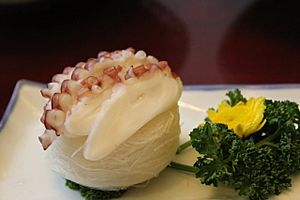Sukhoe facts for kids

Muneo-sukhoe (blanched octopus)
|
|
| Type | Hoe |
|---|---|
| Place of origin | Korea |
| Associated national cuisine | Korean cuisine |
| Korean name | |
| Hangul |
숙회
|
|---|---|
| Hanja |
熟鱠
|
| Revised Romanization | sukhoe |
| McCune–Reischauer | sukhoe |
| IPA | [su.kʰwe̞] |
Sukhoe (Korean: 숙회) is a tasty Korean dish. It's a type of hoe, which means it's often served raw or lightly cooked. For Sukhoe, ingredients like vegetables, seafood, or even certain meats are quickly blanched. Blanching means they are dipped in hot water for a very short time. This makes them slightly cooked but still fresh. People usually eat Sukhoe by dipping it in a special sauce called chojang. Chojang is a mix of spicy gochujang (Korean chili paste) and vinegar.
A Look at Sukhoe's Past
The history of sukhoe goes back a long time in Korea. Some types of sukhoe dishes were even written about in a cookbook from the 1600s. This old cookbook is called Jubangmun. It shows that Koreans have enjoyed these blanched dishes for centuries.
Different Kinds of Sukhoe
There are many exciting kinds of sukhoe, depending on what ingredients are used. Here are a few examples:
- Dureup-hoe (두릅회): This dish uses blanched dureup (angelica-tree shoots). These shoots are served with chojang dipping sauce.
- Gaji-hoe (가지회): For this sukhoe, aubergines (eggplants) are blanched in salty water. They are then sliced thinly and served with a mustard sauce.
- Minari-hoe (미나리회): This version uses blanched or even raw minari (a type of water celery called Oenanthe javanica). It's also served with chojang.
- Muneo-sukhoe (문어숙회): This is a popular seafood sukhoe. Fresh giant octopus is first skinned. Then, it's blanched quickly and served with chojang.
Images for kids







